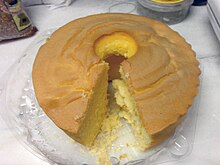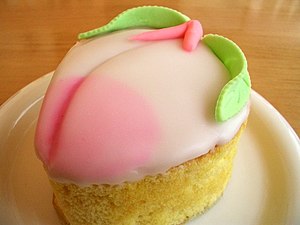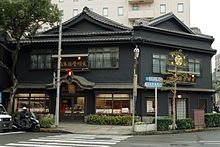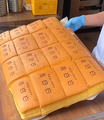| Revision as of 01:32, 15 November 2020 edit198.48.167.69 (talk) Revert has no explanation nor does it address the issues pointed outTags: Undo Reverted Non-autoconfirmed user rapidly reverting edits references removed← Previous edit | Latest revision as of 07:52, 21 December 2024 edit undo2405:1200:28c:5100:5957:6ed7:9adc:92b5 (talk) →See also | ||
| (81 intermediate revisions by 55 users not shown) | |||
| Line 1: | Line 1: | ||
| {{Short description|Japanese sponge cake}} | |||
| {{other uses}} | {{other uses}} | ||
| {{multiple issues| | |||
| {{original research|date=December 2012}} | |||
| {{more citations needed|date=December 2012}} | |||
| }} | |||
| {{Infobox prepared food | {{Infobox prepared food | ||
| | name = Castella | | name = Castella | ||
| Line 11: | Line 8: | ||
| | alternate_name = | | alternate_name = | ||
| | country = ] | | country = ] | ||
| | region = Japan, Taiwan | |||
| | creator = | | creator = | ||
| | type = ] | | type = ] | ||
| Line 20: | Line 18: | ||
| }} | }} | ||
| {{Nihongo|'''Castella'''|カステラ|kasutera}} is a type of Japanese ] and is known for its sweet, moist ]-style flavour and texture. It is based on cakes introduced to Japan by ] merchants in the 16th century. It was then popularized in the city of ], where it is considered a specialty.<ref name="Naomichi p94">{{cite book |last1=Naomichi |first1=Ishige |date=2014 |title=The History and Culture of Japanese Food |publisher=Routledge |page=94 |isbn=978-0710306579}}</ref> Despite its foreign origins, it is considered a kind of '']'', or traditional Japanese confectionery.<ref name="jwa2">{{cite web|url=https://www.wagashi.or.jp/monogatari/shiru/syurui/|archive-url=https://web.archive.org/web/20240216105659/https://www.wagashi.or.jp/monogatari/shiru/syurui/|script-title=ja:その2和菓子の種類|language=ja|publisher=Japan Wagashi Association|date=|archive-date=16 February 2024|access-date=22 February 2024}}</ref><ref name="ndl1">{{cite web|url=https://www.ndl.go.jp/kaleido/entry/25/1.html|archive-url=https://web.archive.org/web/20240222142945/https://www.ndl.go.jp/kaleido/entry/25/1.html|script-title=ja:駆け足でたどる和菓子の歴史|language=ja|publisher=]|date=|archive-date=22 February 2024|access-date=22 February 2024}}</ref><ref name="jwa1">{{cite web|url=https://www.wagashi.or.jp/monogatari/shiru/rekishi/|archive-url=https://web.archive.org/web/20240222142803/https://www.wagashi.or.jp/monogatari/shiru/rekishi/|script-title=ja:その1和菓子の歴史|language=ja|publisher= Japan Wagashi Association|date=|archive-date=22 February 2024|access-date=22 February 2024}}</ref> | |||
| {{Nihongo|'''Castella'''|カステラ|kasutera}} is a kind of '']'' (a Japanese traditional confectionery) originally developed in Japan based on the "Nanban confectionery" (confectionery imported from abroad to Japan during the ] and is currently classified as a type of Japanese confectionery) transmitted from ]. There is no confectionery called “Castella” in Portugal, and the prototype confectionery described later also differs in appearance and manufacturing method from Kasutera (Castella). ] regarded as the birthplace of castella, and the so-called "Nagasaki Kasutera" is based on Fukusaya in ] City, ], and does not mean a famous confection in Nagasaki Prefecture, but is a generic term for those which have the same manufacturing method. The batter is poured into large square or rectangular molds, baked in an oven and cut into long rectangular shapes. Since it uses ], it has a moist texture. | |||
| To suit the tastes of Japanese people, '']'' syrup was added to the sponge cake to make it more moist, and ''zarame'' (coarse sugar) was added to the bottom to give it a coarser texture.<ref name="nagasaki">{{cite web|url=https://www.pref.nagasaki.jp/shared/uploads/2021/04/1618388450.pdf|archive-url=https://web.archive.org/web/20240223113331/https://www.pref.nagasaki.jp/shared/uploads/2021/04/1618388450.pdf|script-title=ja:日本遺産 (Japan heritage)|language=ja|publisher=]|date=|archive-date=23 February 2024|access-date=23 February 2024}}</ref> Castella is usually baked in square or rectangular molds, then cut and sold in long boxes, with the cake inside being approximately {{Cvt|27|cm}} long. | |||
| Now a specialty of ], the cake was brought to Japan by ] merchants in the 16th century. The name is derived from ] ''Pão de Castela'', meaning "bread from ]". Castella cake is usually sold in long boxes, with the cake inside being approximately 27 cm long. It is somewhat similar to ], also associated with Portugal, but its closest relative is ''{{ill|pão-de-ló|pt}}'', also a Portuguese cake. | |||
| == Etymology == | |||
| ⚫ | |||
| ] | |||
| The word "castella" is derived from the Portuguese {{Lang|pt|Bolo de Castela}}, meaning "cake from ]".<ref>{{Cite book|last=Hosking|first=Richard|url=https://www.oxfordreference.com/view/10.1093/acref/9780199677337.001.0001/acref-9780199677337-e-1307|title=The Oxford Companion to Food|publisher=]|year=2014|isbn=9780191756276|editor-last=Davidson|editor-first=Alan|edition=3rd|chapter=kasutera (sometimes spelled castera)|editor-last2=Jaine|editor-first2=Tom}}</ref><ref name="Naomichi p94" /> Its closest relative is '']'', a Portuguese cake. ''Pão-de-ló'' can be in turned derived from the ] ''Pain de lof''<ref>{{Cite web |last=termcoordeditor |date=2021-09-11 |title=I-ATE Food Term of the Week: Pão de Ló {{!}} Terminology Coordination Unit |url=https://termcoord.eu/2021/09/i-ate-food-term-of-the-week-pao-de-lo/ |access-date=2024-03-26 |language=en-GB}}</ref> or ''Gâteau de Savoie''.<ref>{{Cite book |url=https://books.google.com/books?id=AGg_AAAAYAAJ&dq=%22bolo+de+saboia%22++%22p%C3%A3o+de+l%C3%B3%22&pg=PA185 |title=Arte do cosinheiro e do copeiro |date=1845 |publisher=Sociedade Propagadora dos Conhecimentos Uteis |language=pt-BR}}</ref> | |||
| ⚫ | Similar European sponge cakes also reference Spain in their names, such as in {{langx|it|Pan di Spagna}}, in {{Langx|pt|Pão d’Espanha}}, in {{langx|ro|Pandișpan}}, in {{langx|bg|пандишпан}}, in {{langx|sr|патишпањ}}, in {{langx|el|Παντεσπάνι}}, and in {{langx|tr|Pandispanya}}. ] was a former kingdom of ], comprising its north-central provinces, thus these names are quasi-synonymous with "bread from Castile". | ||
| ==History== | ==History== | ||
| ] | ] | ||
| In the 16th century, the ] and soon started trade and missionary work. ] was then the only Japanese port open for foreign commerce. This exchange, called the ], brought many new things to Japan. The Portuguese introduced things such as ], ], ]s, and cakes baked with wheat flour, eggs, and milk. | |||
| ] | |||
| ] | |||
| Castella cakes could be stored for a long time, and so were useful for the sailors who were out on the sea for months. In the ], in part due to the cost of sugar, castella was an expensive dessert to make despite the ingredients sold by the Portuguese. When the ]'s envoy was invited, the ] presented them with castella cakes.<ref>] History of Castella {{webarchive|url=https://web.archive.org/web/20080622200257/http://www.tokyo-bunmeido.co.jp/museum/rekishi/index.html|date=June 22, 2008}}</ref> Over the years, the taste changed to suit Japanese palates. | |||
| ==Varieties== | ==Varieties== | ||
| There are now many varieties made with ingredients such as ], ], and ]. They may be molded in various shapes; a popular ] food is ''baby castella'', a bite-sized version. | There are now many varieties made with ingredients such as ], ], and ]. They may be molded in various shapes; a popular ] food is ''baby castella'', a bite-sized version. | ||
| ''Siberia'', castella cake filled with ] (sweet bean jelly), was popular in the ]; it had a resurgence since it appeared in the 2013 animated film ''] |
''Siberia'', castella cake filled with '']'' (sweet bean jelly), was popular in the ]; it had a resurgence since it appeared in the 2013 animated film '']'', by ].<ref>{{Cite web|url=http://en.rocketnews24.com/2013/09/09/the-old-timey-treat-thats-back-in-style-thanks-to-hayao-miyazaki/|title=The old-timey treat that's back in style thanks to Hayao Miyazaki|date=2013-09-08|website=RocketNews24|access-date=2017-01-08|archive-date=2018-01-02|archive-url=https://web.archive.org/web/20180102020002/https://en.rocketnews24.com/2013/09/09/the-old-timey-treat-thats-back-in-style-thanks-to-hayao-miyazaki/|url-status=dead}}</ref> | ||
| Castella mix is used for the pancakes that are sandwiched together with sweet ] paste in the confection known as '']''. | Castella mix is used for the pancakes that are sandwiched together with sweet ] paste in the confection known as '']''. | ||
| <gallery widths="150px" heights="150px" mode="packed"> | |||
| ==Taiwanese castella== | |||
| Bunmeido Oyatsu-Castella.jpg|Regular and chocolate castella | |||
| ⚫ | Castella were first introduced to Taiwan during the age of ]. In 1968, Ye Yongqing, the owner of a Japanese bakery in Taipei named ''Nanbanto'', partnered with the Japanese company ''Nagasaki Honpu'' to establish a castella business.<ref>{{cite book|title=Official site of Nanbanto|url=https://www.nanmantang.com|year=2018}}</ref> |
||
| Castella.jpg|Strawberry castella | |||
| Siberia2.jpg|Castella with '']'', called "Siberia" in Japan | |||
| Peach castella.jpg|Peach castella | |||
| </gallery> | |||
| === |
===Taiwanese castella=== | ||
| ⚫ | Castella were first introduced to Taiwan during the age of ]. In 1968, Ye Yongqing, the owner of a Japanese bakery in Taipei named ''Nanbanto'', partnered with the Japanese company ''Nagasaki Honpu'' to establish a castella business.<ref>{{cite book|title=Official site of Nanbanto|url=https://www.nanmantang.com|year=2018}}</ref> | ||
| The most popular variety of castella in Taiwan is ''Honey Castella''. Honey is not a necessary ingredient in the original Japanese recipe, and honey castella are therefore uncommon in Japan. However, in Taiwan, customers prefer this modified version of castella, which has a strong scent of thick honey. | |||
| Taiwanese style castella is generally more ]-like than the Japanese variety with a custard like center.<ref name="Japan Times" /> A speciality of ] is a simple pillow shaped castella cake.<ref>{{cite web |last1=Yang |first1=Sophia |title=Taiwan's Castella named next darling in Japan |url=https://www.taiwannews.com.tw/en/news/3840325 |website=www.taiwannews.com.tw |date=19 December 2019 |publisher=Taiwan News |access-date=15 November 2020}}</ref> Taiwanese style castella has been introduced into Japan.<ref name="Japan Times" >{{cite web |last1=St. Michel |first1=Patrick |title=Harajuku's latest dessert trend? Taiwanese castella cake. |url=https://www.japantimes.co.jp/life/2020/11/07/food/harajuku-taiwanese-castella-cake/ |website=www.japantimes.co.jp |date=7 November 2020 |publisher=Japan Times |access-date=7 November 2020}}</ref> | |||
| ===Rock-Baked castella=== | |||
| Another Taiwanese variety, ''rock-baked castella'' is a double-baked cake in a circular shape, with a honey castella base and a cheese-based topping. They are usually more expensive than ''honey castella''. | |||
| <gallery perrow="7"> | |||
| File:Taiwanese Casetella.jpg | |||
| File:Taiwanese Castella 1.png | |||
| File:Taiwanese Castella 2.png | |||
| File:Taiwanese Castella 3.png | |||
| File:Taiwanese Castella 4.png | |||
| File:ファミマの台湾カステラ.jpg | |||
| </gallery> | |||
| == Main manufacturers == | |||
| ]]] | |||
| *Founded in 1624: ] (], ]) | |||
| *Founded in 1681: ] (Nagasaki City, Nagasaki Prefecture) | |||
| *Founded in 1900 (] 33): ] (Nagasaki City, Nagasaki Prefecture) Known for the phrase "castella first, telephone number second" and in the ], commercials of bear puppets dancing can-can dances.<ref>{{cite web|date=February 9, 2014 |website=YouTube |script-title=ja:懐かしいCM 文明堂 カステラ 「文明堂豆劇場」 |url=https://www.youtube.com/watch?v=mJt2Y0DobQo}}</ref> | |||
| ==See also== | ==See also== | ||
| *] | *] | ||
| *] | *] | ||
| *] | |||
| ==References== | ==References== | ||
| Line 56: | Line 78: | ||
| ==External links== | ==External links== | ||
| * | |||
| * ] | |||
| * | |||
| * | |||
| * | |||
| {{Commons category|Castella (food)|position=left}} | {{Commons category|Castella (food)|position=left}} | ||
| Line 66: | Line 84: | ||
| {{Authority control}} | {{Authority control}} | ||
| ⚫ | ] | ||
| ] | |||
| ] | ] | ||
| ] | ] | ||
| ⚫ | ] | ||
Latest revision as of 07:52, 21 December 2024
Japanese sponge cake For other uses, see Castella (disambiguation). | |
| Type | Sponge cake |
|---|---|
| Place of origin | Japan |
| Region or state | Japan, Taiwan |
| Main ingredients | Flour, sugar, eggs, mizuame |
Castella (カステラ, kasutera) is a type of Japanese sponge cake and is known for its sweet, moist brioche-style flavour and texture. It is based on cakes introduced to Japan by Portuguese merchants in the 16th century. It was then popularized in the city of Nagasaki, where it is considered a specialty. Despite its foreign origins, it is considered a kind of wagashi, or traditional Japanese confectionery.
To suit the tastes of Japanese people, mizuame syrup was added to the sponge cake to make it more moist, and zarame (coarse sugar) was added to the bottom to give it a coarser texture. Castella is usually baked in square or rectangular molds, then cut and sold in long boxes, with the cake inside being approximately 27 cm (11 in) long.
Etymology

The word "castella" is derived from the Portuguese Bolo de Castela, meaning "cake from Castile". Its closest relative is pão-de-ló, a Portuguese cake. Pão-de-ló can be in turned derived from the French Pain de lof or Gâteau de Savoie.
Similar European sponge cakes also reference Spain in their names, such as in Italian: Pan di Spagna, in Portuguese: Pão d’Espanha, in Romanian: Pandișpan, in Bulgarian: пандишпан, in Serbian: патишпањ, in Greek: Παντεσπάνι, and in Turkish: Pandispanya. Castile was a former kingdom of Spain, comprising its north-central provinces, thus these names are quasi-synonymous with "bread from Castile".
History

In the 16th century, the Portuguese reached Japan and soon started trade and missionary work. Nagasaki was then the only Japanese port open for foreign commerce. This exchange, called the Nanban trade, brought many new things to Japan. The Portuguese introduced things such as guns, tobacco, pumpkins, and cakes baked with wheat flour, eggs, and milk.
Castella cakes could be stored for a long time, and so were useful for the sailors who were out on the sea for months. In the Edo period, in part due to the cost of sugar, castella was an expensive dessert to make despite the ingredients sold by the Portuguese. When the Emperor of Japan's envoy was invited, the Tokugawa shogunate presented them with castella cakes. Over the years, the taste changed to suit Japanese palates.
Varieties
There are now many varieties made with ingredients such as powdered green tea, brown sugar, and honey. They may be molded in various shapes; a popular Japanese festival food is baby castella, a bite-sized version.
Siberia, castella cake filled with yōkan (sweet bean jelly), was popular in the Meiji era; it had a resurgence since it appeared in the 2013 animated film The Wind Rises, by Hayao Miyazaki.
Castella mix is used for the pancakes that are sandwiched together with sweet adzuki bean paste in the confection known as dorayaki.
-
 Regular and chocolate castella
Regular and chocolate castella
-
 Strawberry castella
Strawberry castella
-
 Castella with yōkan, called "Siberia" in Japan
Castella with yōkan, called "Siberia" in Japan
-
 Peach castella
Peach castella
Taiwanese castella
Castella were first introduced to Taiwan during the age of Taiwan under Japanese rule. In 1968, Ye Yongqing, the owner of a Japanese bakery in Taipei named Nanbanto, partnered with the Japanese company Nagasaki Honpu to establish a castella business.
Taiwanese style castella is generally more soufflé-like than the Japanese variety with a custard like center. A speciality of Tamsui is a simple pillow shaped castella cake. Taiwanese style castella has been introduced into Japan.
Main manufacturers

- Founded in 1624: Castella Honke Fukusaya (Nagasaki City, Nagasaki Prefecture)
- Founded in 1681: Shooken (Nagasaki City, Nagasaki Prefecture)
- Founded in 1900 (Meiji 33): Bunmeidō (Nagasaki City, Nagasaki Prefecture) Known for the phrase "castella first, telephone number second" and in the Kanto region, commercials of bear puppets dancing can-can dances.
See also
References
- ^ Naomichi, Ishige (2014). The History and Culture of Japanese Food. Routledge. p. 94. ISBN 978-0710306579.
- その2和菓子の種類 (in Japanese). Japan Wagashi Association. Archived from the original on 16 February 2024. Retrieved 22 February 2024.
- 駆け足でたどる和菓子の歴史 (in Japanese). National Diet Library. Archived from the original on 22 February 2024. Retrieved 22 February 2024.
- その1和菓子の歴史 (in Japanese). Japan Wagashi Association. Archived from the original on 22 February 2024. Retrieved 22 February 2024.
- 日本遺産 (Japan heritage) (PDF) (in Japanese). Nagasaki Prefecture. Archived from the original (PDF) on 23 February 2024. Retrieved 23 February 2024.
- Hosking, Richard (2014). "kasutera (sometimes spelled castera)". In Davidson, Alan; Jaine, Tom (eds.). The Oxford Companion to Food (3rd ed.). Oxford University Press. ISBN 9780191756276.
- termcoordeditor (2021-09-11). "I-ATE Food Term of the Week: Pão de Ló | Terminology Coordination Unit". Retrieved 2024-03-26.
- Arte do cosinheiro e do copeiro (in Brazilian Portuguese). Sociedade Propagadora dos Conhecimentos Uteis. 1845.
- Bunmeidou History of Castella Archived June 22, 2008, at the Wayback Machine
- "The old-timey treat that's back in style thanks to Hayao Miyazaki". RocketNews24. 2013-09-08. Archived from the original on 2018-01-02. Retrieved 2017-01-08.
- Official site of Nanbanto. 2018.
- ^ St. Michel, Patrick (7 November 2020). "Harajuku's latest dessert trend? Taiwanese castella cake". www.japantimes.co.jp. Japan Times. Retrieved 7 November 2020.
- Yang, Sophia (19 December 2019). "Taiwan's Castella named next darling in Japan". www.taiwannews.com.tw. Taiwan News. Retrieved 15 November 2020.
- 懐かしいCM 文明堂 カステラ 「文明堂豆劇場」. YouTube. February 9, 2014.





